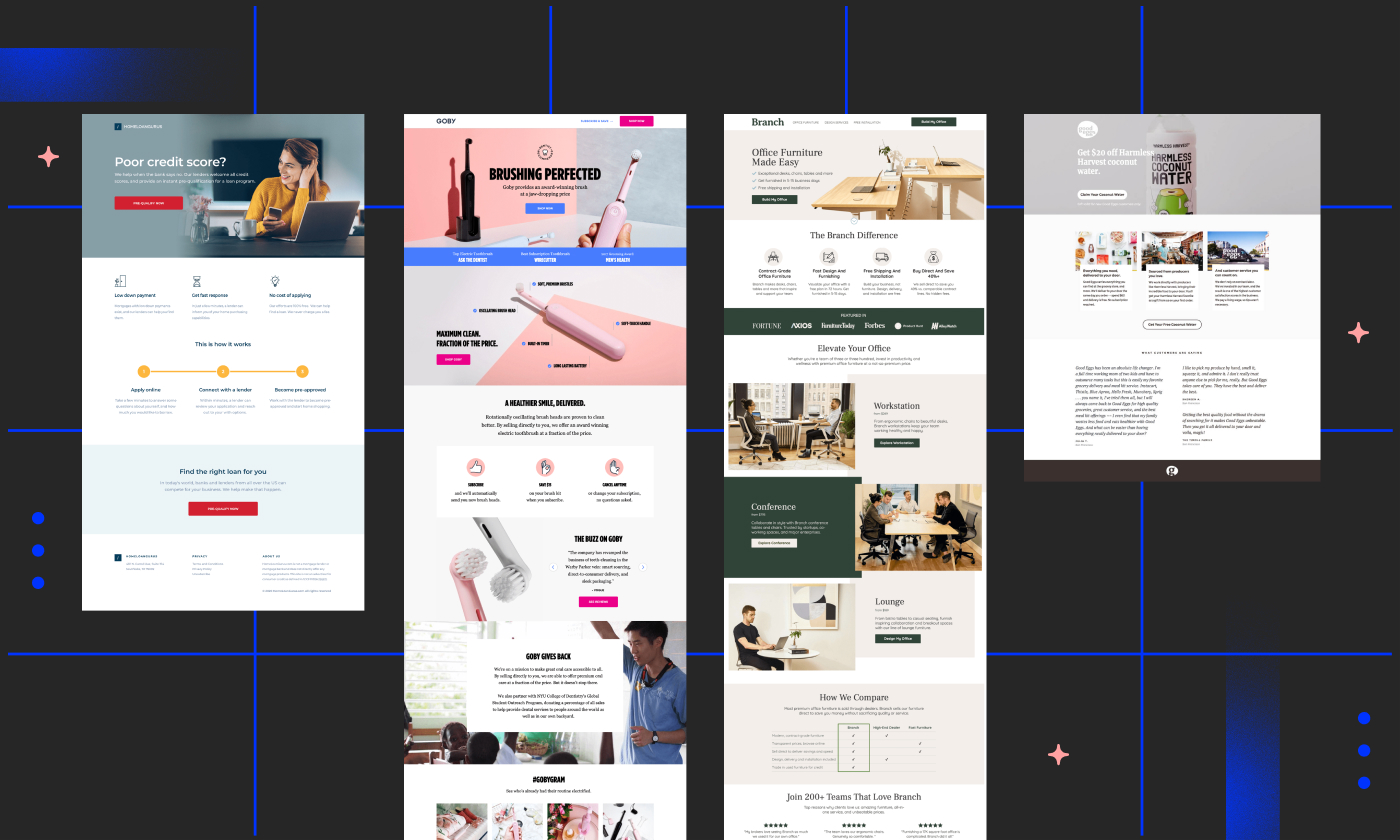What is a WordPress landing page?
A WordPress landing page is exactly what it sounds like—a dedicated landing page built on your WordPress site.
But here’s what makes it special: unlike your regular web pages full of menus and links, a landing page has one job and one job only. It’s a custom, standalone page focused on getting visitors to take a single action.
Do you need a custom landing page?
Picture this: You’re running Facebook ads for your new social media marketing guide. You’ve crafted the perfect ad copy, picked your audience, and the clicks are rolling in.
Without a landing page…
Those precious ad clicks land on your homepage. Your visitors see your main menu, your latest blog posts about email marketing, and that busy sidebar. They hunt around for your guide, get frustrated, and bounce. Your ad spend? Pretty much wasted.
With a landing page…
Every click goes straight to a clean, focused page that matches your ad. Your guide is front and center, with three quick benefits and a simple email form. No distractions eating into your conversion rate. Just happy new leads downloading your guide.
See the difference? That’s the power of WordPress landing pages. They turn your ad spend into actual results by giving your visitors exactly what you promised—no confusion, no dropoffs.
The difference between WordPress pages and landing pages
Let’s clear up a common mix-up. Your regular WordPress website pages are like a busy shopping mall—lots to explore, menus everywhere, and plenty of paths to wander down. And that’s perfect for your main site where you want visitors browsing around.
But a standalone page built specifically for conversions? That’s different. A WordPress landing page is more like a pop-up shop with one amazing product. No food court distractions, no window shopping—just your offer and a clear path to say “yes.”
Here’s why this matters:
When you’re spending money on ads or email campaigns, you need a distraction-free landing page that focuses visitors on one thing only. Not your blog posts, not your about page, not your latest company news. Just the offer they clicked to see and how to get it.
Think of it this way: Your WordPress site tells your whole story. Your landing page tells just the chapter that matters right now.
Karine Bengualid
Karine Bengualid is a freelance content writer over at Brought To You By the Letter K with a teensy penchant for Sesame Street. She writes audience-specific stories to connect brands with their ideal customers. When she’s not saving the world from un-fun marketing or researching everything about the science of fun, she’s building her animal rescue, Maison Misha.
» More blog posts by Karine Bengualid
Banafshe Salehi
Banafshe is a writer and creator who loves long walks on the beach (kidding?). When she’s not selling you on her puns or her pop-culture analogies, she can be found at the busiest intersection in her city with her headphones. Which are totally not falling apart.
» More blog posts by Banafshe Salehi
Josh Gallant
Josh is the founder of Backstage SEO, an organic growth consulting firm that helps B2B SaaS companies capture demand from search. He’s a self-proclaimed spreadsheet nerd by day, volunteer soccer coach by night (and weekends), and wannabe fantasy football expert every fall.
» More blog posts by Josh Gallant
Should you build your landing page in WordPress or use another tool?
Here’s a question we hear all the time: “Should I build my landing pages right in WordPress or use a separate tool?”
Why WordPress is the smart choice for landing pages
Both options can work. But if you’re already using WordPress for your site, keeping your landing pages there makes a lot of sense. Here’s why:
First—everything stays under one roof. Your WordPress site becomes your command center. No jumping between different tools or remembering extra passwords. Your pages, plugins, and analytics all live in the same place. Nice and simple.
Plus, you get all the perks of WordPress right out of the box:
- Your favorite WordPress plugins work instantly.
- Your SEO setup can carry over automatically.
- Your existing tools and integrations? They just work.
Even if you’re building and managing your landing pages through WordPress, a dedicated landing page builder should be a non-negotiable.
Why you need a landing page builder (trust us on this one)
So why exactly is a landing page builder non-negotiable? Think of it this way: You wouldn’t build a house with just a hammer, right? Same idea here.
Here’s what a good landing page builder gives you that WordPress alone can’t:
- Templates you can customize in minutes (not days)
- Simple drag-and-drop editing (no code required)
- Built-in testing tools to improve your results
- Mobile-friendly designs that work right away
We’ve seen people try the DIY route—building from scratch or hiring developers. But here’s the reality: Your time is valuable. A landing page builder pays for itself by turning what used to be weeks of work into a few hours of clicking and customizing.
Plus, when you combine WordPress’s built-in perks with a proper landing page builder? That’s when the magic happens. You get all those WordPress benefits we just talked about, plus the power to create and test pages at lightning speed.
The key elements of a high-converting WordPress landing page
Want to know what separates a high converting landing page from one that flops? It’s not magic—it’s method. Every click on your ad is a win, but what happens next makes all the difference. Let’s break down the must-have elements that turn those clicks into customers.
1. Match your ad messaging (and mean it)
Here’s the thing about creating landing pages: what you promise in your ad needs to match what visitors see when they land. Think of it like a first date—if your dating profile says you’re a chef but you show up in a lawyer’s suit, that’s going to raise some eyebrows.
Your landing page design should feel like a natural continuation of your ad. Same message, same look, same promise. That’s how you build trust from the first second.
2. Make your first impression count
The moment someone hits your landing page, two things need to grab their attention:
- A headline that speaks directly to their needs
- A hero image that backs up your message
Beautiful landing pages aren’t just about looks—they’re about instant understanding. Your visitors should know exactly what they’re getting within three seconds.
3. Write copy that converts
Your landing page content needs to do one job: move people toward action. Keep it clear, keep it focused, and make every word count.
Think about it this way: if your friend asked what your offer was about, you wouldn’t give them a 20-minute speech. You’d tell them the good stuff first. Do the same here.
Want to encourage visitors to stick around? Break up your text into bite-sized chunks and highlight the benefits they care about most.
Bonus tip: if you need help writing compelling landing page copy, try using Smart Copy to help you put all the right words together using AI.
4. Add a form that works
If you’re aiming to create a landing page that generates leads, your custom form landing page needs to strike the right balance. Ask for too much info? People bounce. Ask for too little? Your sales team won’t be happy.
- Start with just the essentials (usually email and name)
- Add 1-2 qualifying questions if you really need them
- Make your dedicated form landing page feel like a natural part of the conversation
5. Build in social proof
High converting landing pages almost always include proof that you can deliver. Think testimonials, case studies, or simple stats that show you know your stuff.
But here’s the key: keep it real.
One genuine customer story beats ten generic, empty testimonials every time.
6. Nail your call-to-action
Your call to action continues the journey. Make it clear, make it action-focused, and—this is important—make it match what people expect to get.
Pro tip: If your landing page goes beyond what’s visible on screen, drop in that CTA button more than once. Because let’s be honest, nobody likes scrolling back up.
7. Make it work on mobile
Last but definitely not least: your landing page’s performance on mobile can make or break your success. Most people will see your page on their phones, so test everything on mobile first.
Remember: a high converting landing needs to work everywhere, not just on your laptop. In Q1 of 2023, 95.3% of the world accessed the internet via mobile phone, compared to 57.9% via personal laptop or desktop. So like it or not, everything you do should be mobile-friendly.
Give mobile users the same smooth experience, and you’ll see your conversion rates climb.
Need to make tweaks? That’s what testing is for. Keep an eye on your numbers and adjust as you go. The best landing pages are never really “done”—they just keep getting better.
How to create a landing page in WordPress
Now that you see the value in creating landing pages for your marketing campaigns, let’s get to the how of creating a high-converting landing page for your WordPress website.
For the sake of this tutorial, we’ll assume you already have a WordPress website.
You have several options to build your page.
- Hire a programmer to build one from scratch. This option can get costly if you plan to build multiple pages, plus it takes time to find the right developer who understands the needs of your business.
- Use the default WordPress block editor. You’ll need to learn some basic HTML code and a programmer to make significant design changes.
- WordPress landing page builder. A visual drag-and-drop builder is the easiest option that requires zero coding and will give you access to hundreds of customizable templates.
Depending on scope and scale, all options have their value. But if we’re good mind-readers, we know which one you’re eyeing by now.
Create a WordPress landing page with Unbounce’s landing page builder
Since we like to hit the easy button around here as much as possible, this tutorial will show you how to create a landing page in WordPress using the Unbounce templates and drag-and-drop page builder. We might be biased, but we do think it’s one of the best WordPress landing page plugins around.
Here’s a step-by-step guide to creating a WordPress landing page.
Step 1: Install the Unbounce WordPress plugin
First things first, head on over to your WordPress site, login and navigate to your dashboard.
On the left side of the page, find “plugins” and click on it. This will open up a drop-down menu and also take you to the plugins page.
Next, click on “add plugin.” In the search bar, type in “Unbounce Landing Pages,” and it will bring up the plugin to install. You can also navigate directly to it here.
Once you’ve clicked “install” and then “activate,” you’ve successfully installed the plugin, and you’re ready to build your first WordPress landing page. Congrats.
Step 2: Create an account with Unbounce
If you haven’t already, sign up for an Unbounce account. There’s a free trial period, so you can explore its features and decide if it meets your needs.
Next, log in to your Unbounce account and click on “Create New.”
Step 3: Customize your landing page
From here, you can comb through over 100 WordPress landing page templates and pick one that matches your campaign goals, or you can answer a few questions about your page goals with Smart Builder, and our AI will suggest the best WordPress landing page template for you.
Change colors and fonts, swap out images, and update the heading and text to match your branding and campaign goals.
Step 4: Publish your WordPress landing page
It’s time to take your awesome new WordPress landing page live. Here are the quick-fire steps:
- Click the “Publish” button in Unbounce.
- Since you’ve already installed the WordPress plugin on your website, you need to add your landing page to WordPress to connect your domain to Unbounce. From your Unbounce dashboard, select “Domains” on the left side of your screen. Once you click that, you’ll be prompted to select “Connect a WordPress Domain.”
- With the Unbounce WordPress plugin installed and connected, you can embed your Unbounce landing page into your WordPress site. Head back to your WordPress dashboard and click “Pages” on the left-side menu.
- Then, click “Create a new page” or edit an existing one where you want to display your new landing page.
- In the page editor, you should now see an “Unbounce” button or section. Click it.
- Select the Unbounce landing page you want to embed from the list of your Unbounce pages.
- Customize the settings if necessary, and click “Insert.”
- After embedding your Unbounce landing page into your new WordPress page, you can publish it on your website. Click “Publish” or “Update” to make it live.
Step 5: Test your WordPress landing page
Always test your landing page—always test everything, for that matter—before sending traffic to it. The last thing you need is to spend money promoting it only to discover it’s full of glitches.
Check form submissions, links, and mobile responsiveness. Be sure to test it on a few different browsers, and make sure it functions as expected within your WordPress site.
Step 6: Promote your new WordPress landing page
Now that your Unbounce landing page is embedded into your WordPress site and you’ve tested it to ensure everything works (phew), it’s time to start driving traffic to it.
Although landing pages are typically used in PPC ad campaigns, nothing is stopping you from promoting them on your other channels, as well. Think email marketing, social media, retargeting campaigns, and more.
Here are a few ideas to get your WordPress landing page around:
- Email marketing: Leverage your email list by sending targeted email campaigns that direct subscribers to your landing page. Use your superior copywriting skills (or Smart Copy) to craft catchy copy and subject lines that entice people to click through to your page.
- Social media: Share your landing page on your social media profiles directly in a post that highlights the benefits of your offer. Include a clear CTA or add it to your bio with a link to the landing page.
- Content marketing: If you have a blog or create other types of content, promote your landing page within your articles or blog posts when relevant. For example, if you’re offering an e-book, include a CTA to the landing page in related blog posts.
- Retargeting: Implement retargeting or remarketing campaigns to reach visitors who have previously interacted with your website but did not convert. Show them tailored ads that encourage them to return to your landing page.





![[Build – MOFU] Landing Page Templates – V1 – 2024 landing page templates](jpg/blog-visual-cta-2x-v2.jpg)




